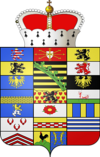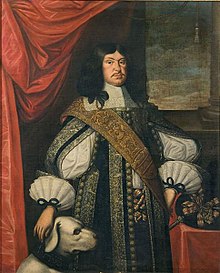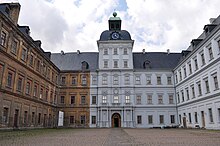Saxony-Weissenfels
|
Territory in the Holy Roman Empire |
|
|---|---|
| Saxony-Weissenfels | |
| coat of arms | |

|
|
| map | |

|
|
| State territory of the Duchy of Saxony-Weißenfels 1657 (red)
|
|
| Arose from | Sharing of course axes |
| Form of rule | Secondary school principality |
| Ruler / government |
Dukes : 1656–1680 August 1680–1697 Johann Adolf I. 1697–1712 Johann Georg 1712–1736 Christian 1736–1746 Johann Adolf II.
|
| Capitals / residences | Weissenfels |
| Dynasties | Sideline of the Albertine Wettins |
| Denomination / Religions | Lutheran |
| Language / n |
German
|
| currency | Valleys |
| Incorporated into |
Electoral Saxony
|
The Duchy of Saxony-Weißenfels was a secondary school principality and territory in the Holy Roman Empire . It existed from 1656/57 to 1746. The royal seat was Weißenfels . The duchy was in possession of a sideline of the Albertine Wettins .
Since the founder of the line, Duke August as administrator of the Archbishopric of Magdeburg, resided in Halle ad Saale and the ducal headquarters, Neu-Augustusburg Castle, had to be built, the names Sachsen-Magdeburg and Sachsen-Halle are occasionally used for his reign used. To distinguish between the two domains, the monastery and the hereditary lands are also used, as only the latter are passed on to the descendants.
history
Emergence
The Saxon Elector Johann Georg I decreed in his will of July 20, 1652 that his three younger sons, who were not entitled to any part of the Kurlande, should receive secondary education principalities for their material needs . After the elector died on October 8, 1656, the " Friend Brothers Main Settlement " was concluded on April 22, 1657 in Dresden and another settlement in which the three territories and the associated sovereign rights were finally delimited and in which it was the Johann brothers George II succeeded in achieving partial success in terms of their striving for sovereignty. The Albertine branch lines of Saxony-Weissenfels, Saxony-Merseburg and Saxony-Zeitz emerged , which established their own duchies.
Duke August, residing in Halle, laid the foundation stone for Neu-Augustusburg in 1660 , which was to be the domicile of the Dukes of Saxony-Weißenfels in the future. His son, Duke Johann Adolf I, completed the building in 1694 and was the first to move into the newly designed baroque palace.
Hereditary lands of the Duchy of Saxony-Weißenfels
Prince August, the second son of the elector, at that same time administrator of the Archbishopric of Magdeburg, received from the Thuringian circle the offices Weissenfels (with the city of Weissenfels and Langendorf ) Freyburg (with the town of Freyburg and the Neuenburg castle ), Sachsenburg (with the city of Sachsenburg ), Sangerhausen (with Pölsfeld as well as the city and castle Sangerhausen ), Eckartsberga (with the cities Eckartsberga and Bad Bibra ) and Weißensee (with the city Weißensee and the Runneburg ) as well as the district office Langensalza (with the city Langensalza and the castle Dryburg ) "Including all gradients, inclusions and affiliations of the team, interest, forwergen, fields, meadows, taxes, services, wooded areas, mills, shepherds, lakes, ponds, fishing yards, courts, wild horses, customs, escorts, mines, sovereigns Authority and other glories ”.
Since Duke August repeatedly made claims to the entire Thuringian district of the electorate, Elector Johann Georg II later felt compelled to add Thamsbrück , Röblingen , Laucha , Müelte and Kindelbrück to the Weißenfels line , as well as the Beuditz monasteries and monasteries near Weißenfels , Bornrode , Kölleda , St. Kaltenborn , Rohrbach , Salza , St. Ulrich and Weißenfels.
Principality of Saxony-Querfurt as another territory of the Weißenfelser
A second, different property complex of the branch line formed the four so-called eximized offices of the Archbishopric of Magdeburg : Querfurt (with city and castle Querfurt ), Jüterbog (with Jüterbog ), Dahme (with city and castle Dahme ) and castle (with castle ). These had already been awarded to Electoral Saxony in the Peace of Prague of 1635 and were also excluded from the Treaty of Westphalia , according to which the Archbishopric of Magdeburg was to be transferred to Brandenburg after the death of Administrator August as a replacement for Western Pomerania, which fell to Sweden. In 1652, Elector Johann Georg I transferred these four exempted offices to the administrator August, his second-born son, to compensate for his renunciation of the diocese of Meissen . The final settlement of the transition took place in the friendly brotherly settlement of 1657. Later there were still some changes: Burg was sold to Brandenburg in 1687 against the abandonment of feudal claims against Dahme, Jüterbog and Querfurt; At the same time, however, the Thuringian offices of Wendelstein (with Wendelstein ), Sittichenbach (with Sittichenbach ) and Heldrungen (with Heldrungen ) were also acquired. The Wendelstein office was only subject to the Principality of Saxony-Querfurt in terms of economy and justice.
From these areas, which essentially represented the rule of Querfurt, which became extinct at the end of the 15th century, the direct imperial principality of Saxony-Querfurt was formed , to which Elector Johann Georg II granted state sovereignty and Emperor Leopold granted a seat and vote in the district council of the Upper Saxon Empire also the name Sachsen-Weißenfels-Querfurt , which is often encountered , although both parts of the area had different status under constitutional law. Although it was an imperial estate , the Principality of Querfurt was denied the right to vote and sit in the Reichstag .
County Barby falls to Weißenfelser
In addition, August received the officially confirmed entitlement to the County of Barby , which fell to Weissenfels in 1659 when the Barby Count House became extinct . The Barbyer Amt Rosenburg (with Rosenburg ) was ceded to Brandenburg in 1679 via intermediate routes. August left Barby in his will to his younger son Heinrich and his descendants, which split off a branch line from the Weissenfels secondary school. However, this died out in the male line in 1739 and fell back to the main line.

Politics and administration
Main line Saxony-Weißenfels-Querfurt ( sovereigns )
- 1656–1680 August (1614–1680)
- 1680–1697 Johann Adolf I (1649–1697)
- 1697–1712 Johann Georg (1677–1712)
- 1712–1736 Christian (1682–1736)
- 1736–1746 Johann Adolf II. (1685–1746)
None of the children of Johann Adolf II reached adulthood and with his death the Duchy fell back to Electoral Saxony .
Branch line Sachsen-Weißenfels-Barby
- 1680–1728 Heinrich (1657–1728)
- 1728–1739 Georg Albrecht (1695–1739)
After the childless death of Georg Albrecht, he falls back on the main line.
Branch line Sachsen-Weißenfels-Dahme
- 1711–1715 Friedrich (1673–1715)
After the childless death of Frederick, falls back to the main line.
More family members
- Johanna Magdalena von Sachsen-Weißenfels (1708–1760), Duchess of Courland
Coat of arms of the duchy
The coat of arms of the duchy of Saxony-Weißenfels was subject to changes over time.
The coat of arms of the Duchy of Saxony-Weißenfels last showed (from left to right): 1. Landgraviate of Thuringia , 2. Duchy of Kleve , 3. Margraviate of Meißen , 4. Duchy of Jülich , 5.-8.-11. Heart shield of the Duchy of Saxony , 6th Duchy of Berg , 7th Duchy of Saxony-Lauenburg , 9th Palatine County of Saxony , 10th Margraviate Oberlausitz , 12th Margraviate Niederlausitz , 13th Pleißenland , 14th County Orlamünde , 15th Margraviate Landsberg , 16th County Brehna , 17th Burgraviate of Altenburg , 18th County of Eisenberg , 19th County of Ravensberg , 20th County of Mark , 21st Regalienschild , 22nd prince county of Henneberg , 23rd County of Barby (since 1660).
Associated offices
Important personalities at the Saxon-Weißenfels court
Georg Handel was the personal physician and valet of the Duke of Saxony-Weißenfels until his death in 1697 . The Duke of Saxony-Weissenfels discovered the talent of his son Georg Friedrich Handel when his personal doctor brought him to Neu-Augustusburg one day to have him play on the Förner organ in the castle church.
From 1729 until his death, Johann Sebastian Bach was the Capellmeister of Saxon-Weissenfels and had previously composed a hunting cantata BWV 208 for the Duke of Sachsen-Weißenfels and a shepherd cantata BWV 249a for the birthday of the Duke of Sachsen-Weißenfels 12 years later . In addition, he specifically wrote one of his most striking organ works for the Förner organ in the castle church, the Toccata and Fugue in F major BWV 540 .
literature
- Joachim Säckl: Saxony-Weissenfels. Territory - Highness - Dynasty , In: Baroque princely residences on Saale, Unstrut and Elster , ed. v. Museum association “The five unequal e. V. “and the Museum Schloss Moritzburg Zeitz, Petersberg 2007, pp. 33–59.
- Hellmut Kretzschmar: On the history of the Saxon secondary school principalities, in: Saxony and Anhalt, Bd. 1, 1925, pp. 312–343 and Bd. 3, 1927, pp. 284–315, ND in: Hellmut Kretzschmar: From the share of Saxony to the recent German history , ed. v. Reiner Groß and Manfred Kobuch (= sources and research on Saxon history, vol. 16), Stuttgart 1999, pp. 141–203.
- O. Posse: The Wettins. Genealogy of the entire Wettin House of the Ernestine and Albertine line. Zentralantiquariat Leipzig 1994 (reprint of the original edition Giesecke & Devrient, Leipzig and Berlin 1897 with corrections and additions). ISBN 3-7463-0171-8
- O. Kaemmel: Saxon history. Hellerau-Verlag, Dresden 1997 (reprint of the 2nd edition by Göschen, Leipzig 1905 with additions). ISBN 3-910184-01-4
- J. John, R. Jonscher and A. Stelzner: History in data: Thuringia. Koehler & Amelang, Munich / Berlin 1995, ISBN 3-7338-0185-7
See also
Web links
- Johann Huebners ... three hundred and three and thirty genealogical tables, Tab. 169
- The story of the five dukes of Weißenfels



